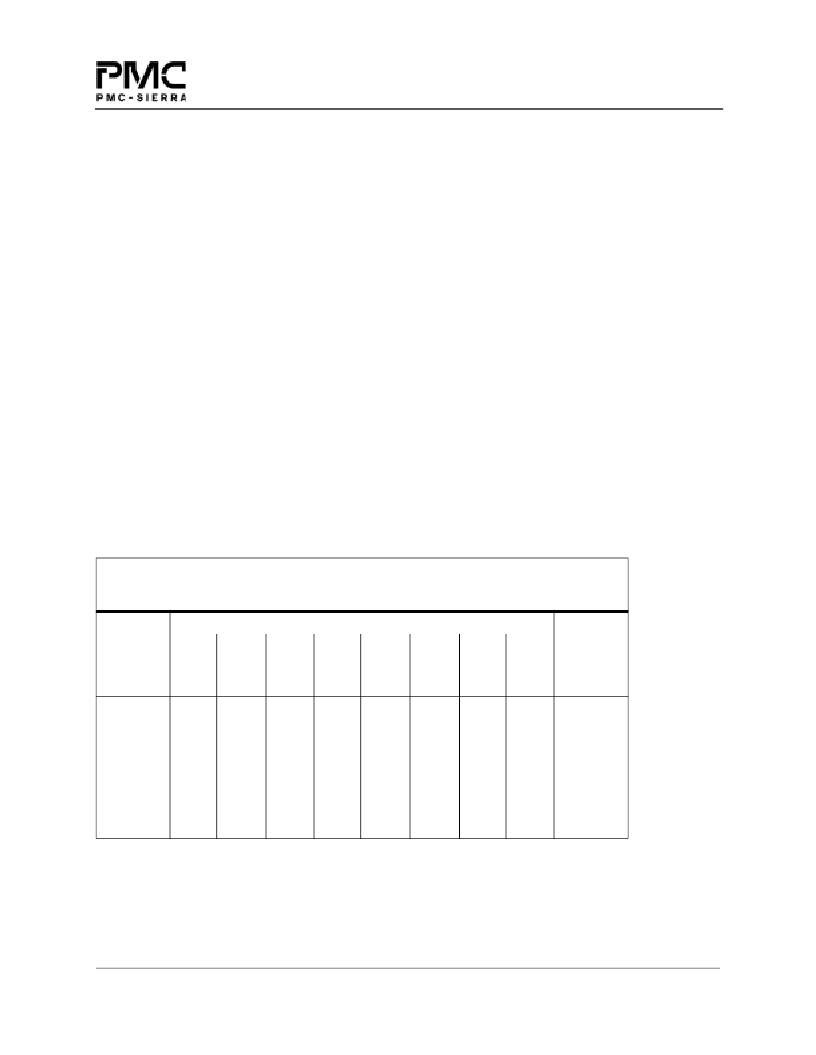- 您現(xiàn)在的位置:買賣IC網(wǎng) > PDF目錄370008 > PM2329 Telecommunication IC PDF資料下載
參數(shù)資料
| 型號(hào): | PM2329 |
| 英文描述: | Telecommunication IC |
| 中文描述: | 通信集成電路 |
| 文件頁數(shù): | 95/162頁 |
| 文件大?。?/td> | 1581K |
| 代理商: | PM2329 |
第1頁第2頁第3頁第4頁第5頁第6頁第7頁第8頁第9頁第10頁第11頁第12頁第13頁第14頁第15頁第16頁第17頁第18頁第19頁第20頁第21頁第22頁第23頁第24頁第25頁第26頁第27頁第28頁第29頁第30頁第31頁第32頁第33頁第34頁第35頁第36頁第37頁第38頁第39頁第40頁第41頁第42頁第43頁第44頁第45頁第46頁第47頁第48頁第49頁第50頁第51頁第52頁第53頁第54頁第55頁第56頁第57頁第58頁第59頁第60頁第61頁第62頁第63頁第64頁第65頁第66頁第67頁第68頁第69頁第70頁第71頁第72頁第73頁第74頁第75頁第76頁第77頁第78頁第79頁第80頁第81頁第82頁第83頁第84頁第85頁第86頁第87頁第88頁第89頁第90頁第91頁第92頁第93頁第94頁當(dāng)前第95頁第96頁第97頁第98頁第99頁第100頁第101頁第102頁第103頁第104頁第105頁第106頁第107頁第108頁第109頁第110頁第111頁第112頁第113頁第114頁第115頁第116頁第117頁第118頁第119頁第120頁第121頁第122頁第123頁第124頁第125頁第126頁第127頁第128頁第129頁第130頁第131頁第132頁第133頁第134頁第135頁第136頁第137頁第138頁第139頁第140頁第141頁第142頁第143頁第144頁第145頁第146頁第147頁第148頁第149頁第150頁第151頁第152頁第153頁第154頁第155頁第156頁第157頁第158頁第159頁第160頁第161頁第162頁

Proprietary and Confidential to PMC-Sierra, Inc and for its Customers
’
Internal Use
Document ID: PMC-2010146, Issue 4
98
PM2329 ClassiPI Network Classification Processor Datasheet
The logical E-Word Width is determined by scanning the D-Word Definition bits from DW6 down to
DW0, until it encounters the first D-Word field that is non-zero, i.e., D-Word that is not absent. The E-
Word width is C-Word plus the number of D-Words present.
E-RAM Width
Indicates the physical width of attached E-RAM. The PM2329 devices in cascade assume that the first
32 bits (i.e., C-Word) are connected to PM2329 #0, next 32 bits are also on CID #0, next 32 bits on CID
#1 and so on. This sequence must be maintained and gaps in the physical connection are not allowed.
The bits are written as follows:
001
32-bit
010
64-bit
011
96-bit
100
128-bit
101
160-bit
110
192-bit
111
224-bit
000
256-bit
Note that the PM2329 cascade allows a larger E-Word to reside in an E-RAM whose physical width is
smaller than the logical E-Word. This will happen whenever the D-Word Definition field indicates a
larger E-Word than what the E-RAM Width field specifies. Consequently, the number of locations
accessed to access the entire E-Word (E-Word Depth) varies. Given the E-Word width and E-RAM
width, the PM2329 automatically enforces a depth of 1, 2 or 4 as shown in the table below.
EMA[18:17] lines carry the ERAM depth field. For most efficient ERAM utilization, EMA[18] and
EMA[17] signals should be connected to the E-RAM devices depending on the depth of the E-Word as
shown in the table below.
Table 20
E-Word Depth Chart
E-Word Depth
for
E-Word Logical Width & E-RAM Physical Width Combinations
Physical
E-RAM
Width
(bits)
32
64
96
128
160
192
224
256
Logical E-Word Width (bits), C-Word plus D-Word
32
64
96
128
4
4
2
1
1
1
1
1
160
NA
4
2
2
1
1
1
1
192
NA
NA
4
2
2
1
1
1
224
NA
NA
4
2
2
2
1
1
256
NA
NA
4
4
2
2
2
1
Number
of
devices
required
1
1
2
3
4
5
6
7
1
1
1
1
1
1
1
1
2
1
1
1
1
1
1
1
4
2
1
1
1
1
1
1
相關(guān)PDF資料 |
PDF描述 |
|---|---|
| PM239P | Analog Comparator |
| PM30RHC060 | TRANSISTOR | IGBT POWER MODULE | 3-PH BRIDGE | 600V V(BR)CES | 30A I(C) |
| PM3321-QC | DATA CROSS CONNECT|LDCC|84PIN|PLASTIC |
| PM355AJ | Voltage-Feedback Operational Amplifier |
| PM355AZ | Voltage-Feedback Operational Amplifier |
相關(guān)代理商/技術(shù)參數(shù) |
參數(shù)描述 |
|---|---|
| PM233-155.52M | 制造商:CONNOR-WINFIELD 制造商全稱:Connor-Winfield Corporation 功能描述:5.0x7.0mm Surface Mount LVPECL Clock Oscillator Series |
| PM2379-001 | 制造商:Delphi Corporation 功能描述:TAPE MARK WHT |
| PM238 | 制造商:PURDY 制造商全稱:PURDY 功能描述:AC Fans and Blowers |
| PM238-115-1751BT-4 | 制造商:INTERFAN 功能描述:Fan, AC, 115V, 172x150x51mm, Obround, 238CFM, 3100RPM, 55dBA, Terminal Block |
發(fā)布緊急采購,3分鐘左右您將得到回復(fù)。